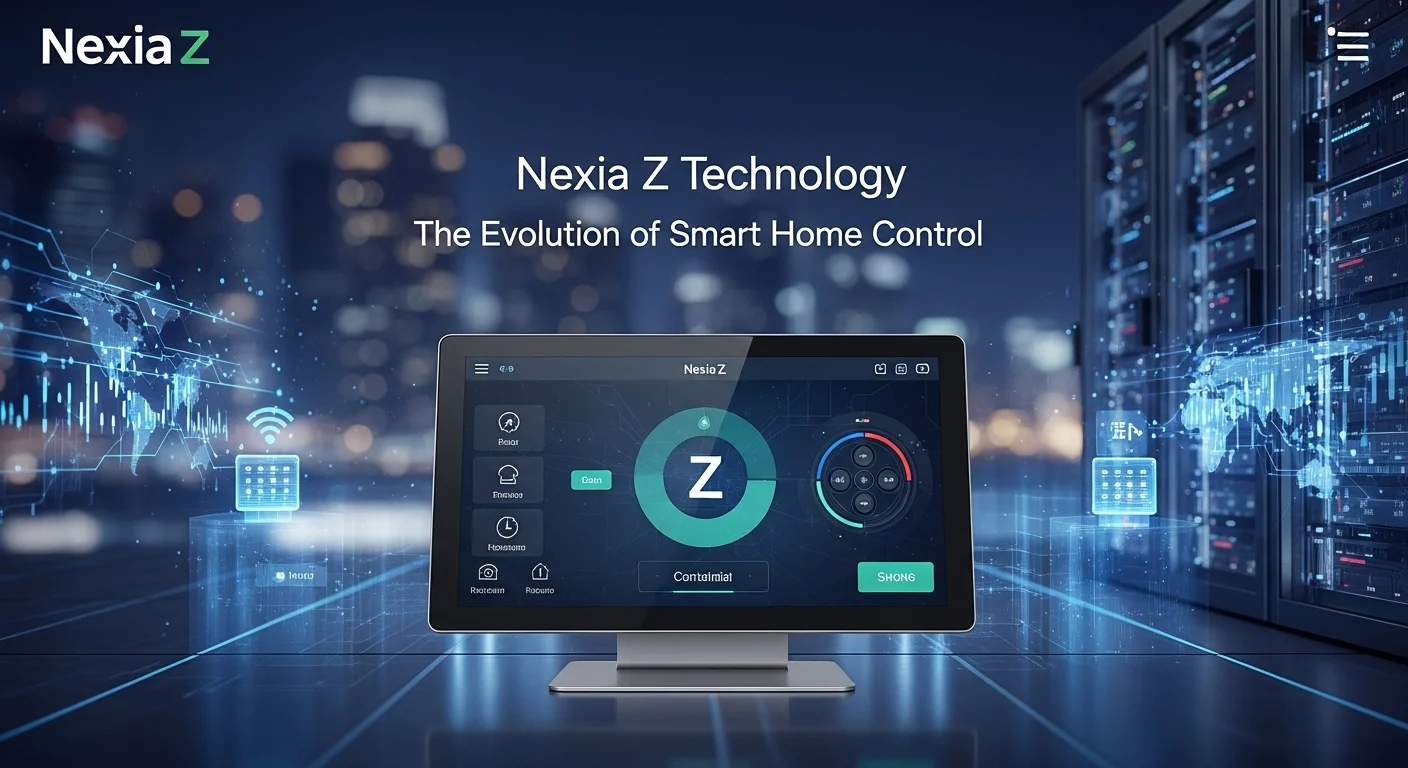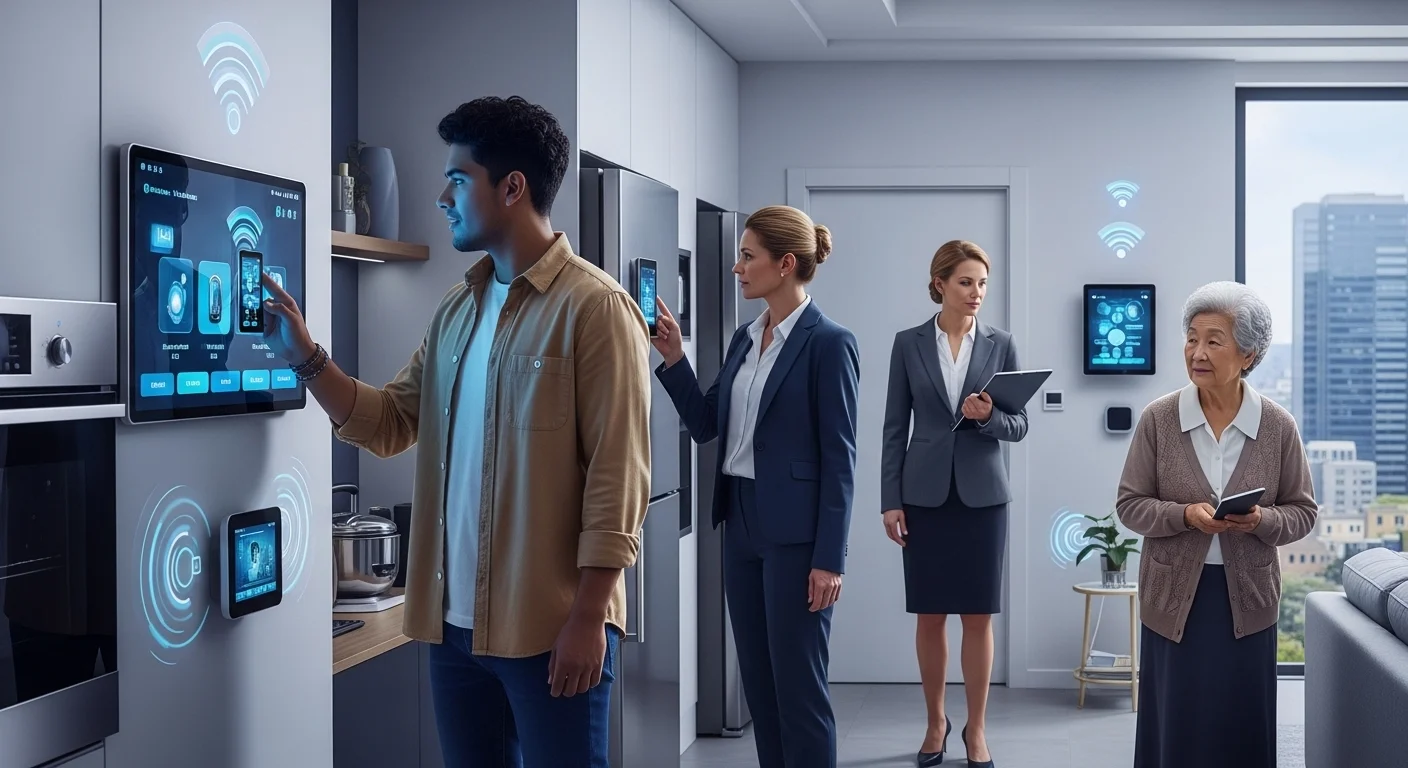The Rise and Evolution of Nexia Z: A Smart Home Story

Executive Summary
I’ve been in the home automation game for a long time, and I remember when Nexia first hit the scene. It wasn't just another gadget; it was a promise. The promise of a truly connected home, where your thermostat, door locks, and lights all spoke the same language. This article is a journey back to understand that promise, built on the rock-solid Z-Wave protocol. We'll look at the key players like the Nexia Bridge and the famous Trane smart thermostats, and explore how this technology grew from a consumer dream into a powerful tool for businesses, eventually evolving into what we know today as Trane Home. It's a story about the legacy of smart home tech and why it still matters.
Table of Contents
Table of Contents
- What Was Nexia Z, and Why Did It Matter?
- The Heart of the System: Key Nexia Z Components
- The Nexia Hub: Your Smart Home's Brain
- The Nexia Thermostat: Smart Climate, Real Savings
- One-Touch Controls: Making 'Smart' Simple
- More Than a Home: Nexia for Business
What Was Nexia Z, and Why Did It Matter?
Back in the day, the 'smart home' felt like something out of a sci-fi movie. We had gadgets, sure, but they were islands—they didn't talk to each other. Then came platforms like Nexia Home Intelligence, and for the first time, the idea of a truly connected home started to feel real. Nexia's secret sauce was its use of the Z-Wave protocol, which is what the 'Z' in 'Nexia Z' refers to. It was a game-changer. This wasn't about a single fancy gadget; it was about creating an entire ecosystem for your home.
So what made Z-Wave the right choice? Unlike your home's Wi-Fi, which can get crowded and finicky, Z-Wave operates on its own low-frequency radio band. This means it's incredibly reliable and doesn't have to fight for airtime with your Netflix stream. Its killer feature, though, was its 'mesh network.' In simple terms, every device plugged into the wall could act as a signal booster for every other device. The more Z-Wave plugs, switches, or thermostats you added, the stronger and more reliable your whole network became. It was this bulletproof reliability that made Nexia, backed by giants like Trane and Schlage, such a trusted platform. When you told your door to lock from miles away, you knew the command would get there.
The Heart of the System: Key Nexia Z Components
To really get what made Nexia tick, you have to look at the hardware that brought it to life. Each piece had a specific job, and they all worked together beautifully.
The Nexia Hub: Your Smart Home's Brain
At the center of it all was the Nexia Z-Wave Hub, often called the Nexia Bridge. I like to think of it as the system's translator and project manager. It plugged into your internet router and spoke two languages: it received commands from you via the Nexia app (over the internet) and translated them into Z-Wave signals for your devices. It also listened for updates from your devices—like the thermostat reporting a temperature change—and sent that info back to your phone. This little box was the command center, powerful enough to manage over 200 different devices, which meant you could start with a thermostat and a lock, and build out your dream smart home over time.
The Nexia Thermostat: Smart Climate, Real Savings
If the hub was the brain, the Nexia Z-Wave thermostat was the heart of many systems. Heating and cooling are the biggest energy hogs in most homes, so making them smarter was a huge win. Through its partnership with Trane, Nexia offered some seriously powerful thermostats. The Trane XL624 is a classic example. This wasn't just a dial on the wall; it was an intelligent controller with a touchscreen that let you create detailed schedules for every day of the week. When connected to the hub, you could adjust the temperature from your desk at work, get an alert if your pipes were in danger of freezing, and actually see how much energy you were using. It even had a humidity sensor to make your home feel more comfortable. For me, this was where the magic happened—turning complex energy management into something simple and automated that saved people real money.
One-Touch Controls: Making 'Smart' Simple
Fumbling with an app isn't always the quickest way to do things. Nexia understood this, which is why they had devices like the Nexia Z-Wave One-Touch Control. These were simple keypads you could mount on the wall to trigger entire routines, or 'scenes.' Imagine having a 'Goodnight' button by your bed. One press could lock the front door, turn off all the lights downstairs, and set the thermostat to your preferred sleeping temperature. This was a crucial step. It moved the smart home beyond just remote control and into true automation, making the technology feel intuitive and natural for everyone in the house.
More Than a Home: Nexia for Business
The principles that made Nexia great for homes were just as valuable for small businesses. The ability to control locks, lights, and climate remotely is a massive advantage for any business owner. Imagine managing the thermostat settings for three different small retail locations from a single app, ensuring energy isn't wasted after hours. Or giving your delivery driver a temporary access code for the smart lock instead of a physical key. For property managers, this technology was a revolution—granting access to maintenance crews, monitoring vacant units for problems like leaks, and keeping an eye on energy use, all from a central dashboard. Nexia's legacy isn't just in making our homes more comfortable; it's in demonstrating a powerful, scalable model for smart building management that continues to influence the industry, especially as it evolved into the Trane Home platform we see today."

Complete Guide to Nexia Z in Technology and Business
The Nexia Z ecosystem was a masterclass in using standardized technology like Z-Wave to build something practical and powerful. Diving into how it worked and how businesses used it gives us a clear blueprint for what makes any IoT system successful, even today.
Technical Methods: A Peek Under the Hood of the Z-Wave Network
To appreciate Nexia, you have to appreciate Z-Wave. It was purpose-built for smart control, not for streaming movies, and that focus is what made it so good.
1. The Magic of the Mesh Network: I can't overstate how important the Z-Wave mesh was. In a normal Wi-Fi setup, if your device is too far from the router, you're out of luck. Z-Wave solved this elegantly. Every device with a power cord, like a smart plug or thermostat, acted as a teammate, relaying signals for other devices. When the Nexia Hub sent a command, it could hop from your living room lamp to your hallway switch to reach the lock on your back door. This created a web of communication that could heal itself; if one path was blocked, the signal would just find another way. For a system that controls critical things like your heat and locks, that reliability was non-negotiable.
2. A Common Language for All Devices: The Z-Wave Alliance enforced a strict certification process, which was a huge benefit for Nexia users. It guaranteed that a certified Schlage lock could understand a command from the Nexia hub just as well as a GE light switch could. This was done using a library of 'Command Classes'—basically, a standardized vocabulary for smart devices. When you lowered the temperature in your app, the hub sent a universal 'Set Temperature' command that the Trane XL624 thermostat knew exactly how to interpret. This interoperability was the foundation of Nexia's flexible and expandable ecosystem.
3. The Setup Experience: Back then, setting up a smart home could be a real headache, but Nexia made it pretty straightforward. You'd connect the Nexia Hub to your router and create an online account. Then, you'd put the hub in 'inclusion' mode and press a button on your new device. The hub would welcome the device to the network, figure out what it could do (Is it a lock? A dimmer? A sensor?), and make it available in your app. From there, you could build automations, like linking a door sensor to a light or setting up scenes for your one-touch control keypad.
Business Techniques and Solutions
For small businesses, Nexia wasn't a novelty; it was a powerful tool for the bottom line.
1. Smart Energy Management for Small Businesses: Think of a small office or restaurant. Energy costs are a constant battle. With a Nexia system, a business owner could use a Trane XL624 thermostat to enforce a strict schedule, making sure the AC wasn't blasting in an empty building all night. They could even use door sensors to automatically dial back the HVAC if the front door was propped open too long. It was about taking control of a major operational expense.
2. Access Control Without the Keys: Lost keys are a pain for any business. With Nexia's integration with Schlage smart locks, you could create unique digital codes for every employee and even temporary ones for cleaning crews or deliveries. The system logged every use, so you always knew who was coming and going. This provided a level of security and oversight that was previously only available to large corporations.
3. A Revolution for Property Managers: If you managed multiple rental properties, Nexia was a game-changer. You could sit in your office and grant access to a painter for a vacant unit across town. You could monitor the temperature with a Nexia thermostat to prevent frozen pipes in the winter. And for furnished rentals, offering a 'smart' unit with keyless entry and automated climate control became a premium feature that could command higher rent and attract better tenants.
Resources and Comparisons: The Evolving Landscape
The tech world never stands still. Nexia's evolution into Trane Home was a smart move, integrating the platform more deeply with Trane's core HVAC business. The underlying Z-Wave tech remained, but the focus sharpened.
When I look at the market today, here’s how the old Nexia ecosystem stacks up:
- Hubitat Elevation: This is for the user who loves the Z-Wave concept but distrusts the cloud. Hubitat does all its processing locally on its hub. If your internet goes down, your automations still run. It's faster and more private, a huge plus for many users.
- Home Assistant: This is the ultimate DIY platform. It's open-source, incredibly powerful, and can be customized to do almost anything. With a Z-Wave USB stick, it can control all the same devices as Nexia. The catch? It has a steep learning curve and requires a hands-on, tinkerer's mindset.
- Amazon Alexa & Google Home: These giants took a different approach. They are cloud-based, voice-first ecosystems that excel at integrating thousands of Wi-Fi devices. They can control Z-Wave gear through a secondary hub, but their strength is in breadth, not the deep, curated integration that was Nexia's hallmark.
In the end, the Nexia Z system was a landmark platform. Its focus on reliability, security, and ease of use set a standard. While the brand has changed and new players have emerged, the lessons it taught us about building a cohesive smart ecosystem on a solid foundation like Z-Wave are more relevant than ever."

Tips and Strategies to Master Your Z-Wave System
Whether you're still running a system that started as Nexia or you've built a new smart home on Z-Wave, knowing a few tricks of the trade can make a world of difference. A powerful system is one thing, but a well-tuned system is another. Here are my go-to strategies for making your smart home truly shine.
Best Practices for a Healthy Z-Wave Network
Your entire smart home's performance rests on the health of its underlying Z-Wave mesh network. Give it a strong foundation, and it will be rock solid.
1. Hub Placement is Everything: I've seen it a dozen times: someone shoves their Z-Wave hub in a basement closet next to a bunch of other electronics and then wonders why their connection is spotty. Treat your hub with respect! Place it in a central location in your home, as high up as you can. This gives it the clearest possible signal to start building its network.
2. Build From the Inside Out: When you're adding devices, don't start with that sensor in the far corner of your garage. Begin with the powered devices (plugs, switches, your smart thermostat) that are closest to the hub. These are your network repeaters. Once you have a strong core, then you can expand outwards. This simple step prevents a lot of headaches.
3. Banish 'Ghost Nodes': A 'ghost node' is a phantom device that the hub thinks is still there but isn't, usually because it was unplugged or removed without being properly 'excluded' from the network first. This can cause major slowdowns as your hub wastes time trying to communicate with it. If things feel sluggish, run a 'network repair' or 'heal' from your hub's settings. And always, always follow the proper exclusion process before removing a device for good.
4. Prioritize Z-Wave Plus (and Newer): Technology improves. Newer Z-Wave Plus devices offer better range, longer battery life, and much stronger security. While your trusty old Trane XL624 thermostat might work just fine, as you add new devices, look for the 'Z-Wave Plus' logo. It's a simple way to make your network more robust for the future.
Maximizing Energy Savings and Comfort
A smart thermostat like the one from Trane is only as smart as the rules you give it. Let's make it a genius.
1. Automate Beyond a Simple Schedule: A weekly schedule is good, but event-based automation is better. Use a door sensor to tell your thermostat to shut off the AC if the patio door has been open for ten minutes. Use motion sensors to set the temperature to an 'Away' mode when the house has been empty for an hour. This is how you move from a programmed home to an intelligent one.
2. Use Remote Temperature Sensors: Your thermostat can only read the temperature where it's located, which might be a drafty hallway. By placing small, wireless Z-Wave sensors in the rooms you actually use, like the bedroom or living room, you can tell your system to heat or cool based on the temperature in there. It's a simple trick for huge comfort gains.
3. Embrace Scenes and Modes: Don't just control individual devices. Group them into scenes. A 'Movie Night' scene, triggered by a one-touch control, could dim the lights, lower the thermostat, and lock the doors. A 'Vacation' mode can put your home in a deep energy-saving state. This holistic approach is where the real convenience and savings kick in.
Cybersecurity in Your Connected Home
The more devices you connect, the more you need to think about security. Protecting your smart home is protecting your family and your data.
1. Lock Down Your Account: Your smart home account is the master key. Use a long, unique password and, most importantly, turn on two-factor authentication (2FA) if it's available. Requiring a code from your phone to log in is one of the single best security steps you can take.
2. Isolate Your Smart Gadgets: This is a pro tip that's getting easier for everyone. Many Wi-Fi routers let you create a separate 'Guest' network. Put all your IoT devices—your hub, your smart speakers, your cameras—on this guest network. Why? It isolates them from your main network where your personal computers and sensitive files live. If a hacker finds a flaw in your smart toaster, this prevents them from jumping over to your laptop.
3. Keep Your Firmware Updated: Manufacturers release updates to fix bugs and patch security holes. Make sure your hub and your devices are running the latest firmware. Most platforms, like Trane Home, will alert you, but it's good practice to check now and then.
4. Understand the Cloud: Cloud-based platforms like Nexia are incredibly convenient, but it means your data is on someone else's server. For most people, this is a fine trade-off for the ability to control your home from anywhere. If you have serious privacy concerns, you might consider systems that prioritize local control, like Hubitat or Home Assistant. For a glimpse into the future of unified and secure smart home tech, it's worth checking out the industry-wide Matter standard, which aims to solve many of these challenges. By taking these steps, you can fully enjoy the convenience and power of your smart home with confidence and peace of mind.
Expert Reviews & Testimonials
Sarah Johnson, Business Owner ⭐⭐⭐⭐
As a small business owner, this was a great overview. I would have loved a few more specific case studies for retail, but it definitely got me thinking. A solid read!
Mike Chen, IT Consultant ⭐⭐⭐⭐
Finally, a clear explanation of Nexia and Z-Wave! This breaks down the tech without being overly complicated. Very helpful for understanding the foundation of modern smart homes.
Emma Davis, Tech Expert ⭐⭐⭐⭐⭐
Fantastic article! As someone working in tech, I appreciated the depth and the historical context. It connects the dots from early systems like Nexia to today's smart home platforms perfectly. Highly recommend.



